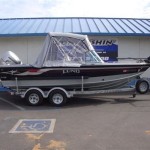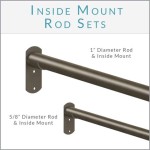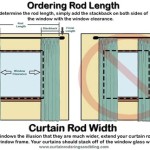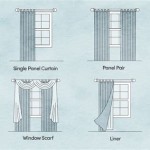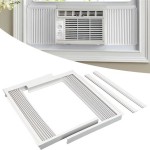Brushed Nickel Shower Curtain Rods: A Comprehensive Guide
Brushed nickel shower curtain rods have become a popular choice in bathroom design, offering a blend of aesthetic appeal, durability, and versatility. The brushed nickel finish, known for its soft, muted sheen, provides a more subtle and less reflective alternative to polished chrome. This article explores the various aspects of brushed nickel shower curtain rods, including their benefits, selection criteria, installation considerations, and maintenance procedures.
Aesthetic and Design Versatility
The aesthetic appeal of brushed nickel stems from its neutral undertones. This characteristic allows it to seamlessly integrate into various bathroom styles, ranging from traditional to contemporary. Unlike chrome, which can appear stark and modern, brushed nickel possesses a warmer, more inviting quality. Its matte finish effectively diffuses light, minimizing fingerprints and water spots, thereby contributing to a cleaner, more presentable appearance. The finish complements other bathroom fixtures finished in brushed nickel, such as faucets, showerheads, and towel bars, creating a cohesive and sophisticated design.
Brushed nickel shower curtain rods are available in a variety of designs, offering homeowners a diverse selection to match their individual preferences. These designs can range from simple, straight rods to curved or angled models. The straight rods are the most common and offer a minimalist aesthetic. Curved rods, on the other hand, can create more space within the shower enclosure, providing a more comfortable showering experience. Angled rods can be useful for fitting unconventional shower spaces or maximizing space in smaller bathrooms. The availability of different finial styles, the decorative ends of the rod, further enhances the design possibilities. Finials can range from simple caps to more elaborate designs, allowing for personalization and the incorporation of specific design elements.
Furthermore, brushed nickel effectively masks minor imperfections that might be more noticeable on a highly polished surface. This feature can be advantageous in bathrooms with less than perfect wall surfaces, as the subtle texture of the brushed nickel tends to downplay any irregularities. The finish lends itself well to a variety of color palettes, complementing both warm and cool tones. It can be paired with neutral colors for a classic, understated look, or used to soften bolder colors, creating a more balanced and harmonious design.
Material Composition and Durability
The durability of a brushed nickel shower curtain rod is closely tied to its underlying material. While the brushed nickel finish provides a protective layer and contributes to the aesthetic appeal, the core material determines the rod’s strength and resistance to corrosion. Common materials used in the construction of these rods include stainless steel, aluminum, and brass. Stainless steel is generally considered the most durable option, offering excellent resistance to rust and corrosion. It is also a strong material, capable of supporting heavier shower curtains without bending or sagging. Aluminum is a lighter and more affordable alternative, but it is generally less resistant to corrosion than stainless steel. Brass is another durable option that offers good resistance to rust and corrosion. However, it can be more expensive than stainless steel or aluminum.
The brushed nickel finish itself is typically applied through a plating or coating process. The quality of this plating significantly affects the rod’s resistance to scratching and wear. A well-applied brushed nickel finish should be durable and resistant to chipping or flaking, even with regular use and exposure to moisture. The thickness of the plating and the preparation of the underlying surface are key factors in determining the longevity of the finish. Some manufacturers also apply a protective clear coat over the brushed nickel to further enhance its durability and resistance to tarnishing.
The gauge or thickness of the material used to construct the rod also plays a crucial role in its overall strength and stability. A thicker gauge material will generally be more durable and less prone to bending or sagging, especially when supporting heavier shower curtains or liners. It is important to consider the weight of the shower curtain and liner when selecting a shower curtain rod, and to choose a rod that is adequately rated to support that weight. The quality of the mounting hardware is equally important. Secure and well-designed mounting brackets will ensure that the rod remains firmly attached to the wall, even with regular use.
Installation and Maintenance Considerations
The installation of a brushed nickel shower curtain rod is generally a straightforward process, but attention to detail is essential to ensure a secure and level installation. The specific installation method will depend on the type of rod and the material of the bathroom walls. Most rods are installed using mounting brackets that are screwed directly into the wall studs or secured with wall anchors. When installing into drywall, it is crucial to use appropriate wall anchors that are rated to support the weight of the rod and the shower curtain. Failure to use adequate anchors can result in the rod pulling away from the wall over time.
Before beginning the installation, it is imperative to carefully measure the shower area and determine the desired height and placement of the rod. Using a level is essential to ensure that the rod is installed horizontally. Marking the location of the mounting brackets with a pencil will help ensure accurate placement. When drilling holes for the mounting brackets, it is important to use the correct size drill bit for the type of wall material and the anchors being used. Applying a bead of caulk around the mounting brackets after installation will help to seal any gaps and prevent water from seeping behind the wall.
Maintaining a brushed nickel shower curtain rod is relatively simple, but regular cleaning is necessary to prevent the buildup of soap scum, water spots, and mildew. A mild soap and water solution is generally sufficient for cleaning the rod. Avoid using abrasive cleaners or scouring pads, as these can scratch or damage the brushed nickel finish. A soft cloth or sponge should be used to gently wipe down the rod and mounting brackets. After cleaning, it is important to rinse the rod thoroughly with clean water and dry it with a soft towel to prevent water spots. For stubborn soap scum or mildew, a solution of vinegar and water can be used. However, it is important to test the solution in an inconspicuous area first to ensure that it does not damage the finish. Regularly inspecting the mounting brackets and tightening any loose screws will help to ensure the rod remains securely attached to the wall.
In areas with hard water, mineral deposits can accumulate on the shower curtain rod over time. These deposits can be removed with a solution of lemon juice and water. Apply the solution to the affected areas, let it sit for a few minutes, and then wipe it clean with a soft cloth. Another option is to use a commercially available bathroom cleaner specifically designed for removing mineral deposits. Always follow the manufacturer's instructions when using these cleaners.
Proper ventilation in the bathroom is also important for preventing the buildup of moisture and mildew. Running the exhaust fan during and after showers will help to reduce humidity levels and protect the shower curtain rod from damage. Choosing a shower curtain and liner that are resistant to mildew will also help to keep the shower area clean and prevent the growth of mold. Replacing the shower curtain liner regularly will further contribute to a hygienic and well-maintained bathroom environment.
Types of Brushed Nickel Shower Curtain Rods
Within the realm of brushed nickel shower curtain rods, several distinct types cater to diverse needs and preferences. These variations extend beyond mere aesthetic differences, encompassing functional attributes that enhance the showering experience and address specific spatial constraints.
Straight Shower Curtain Rods: These are the most ubiquitous and simplistic type, consisting of a linear rod spanning the width of the shower or bathtub. They are relatively easy to install and are suitable for most standard shower configurations. Straight rods are generally adjustable to accommodate different shower widths, providing flexibility in installation. Their straightforward design makes them a cost-effective option for those seeking a functional and understated solution.
Curved Shower Curtain Rods: These rods feature a gentle outward curve, creating additional space within the shower enclosure. This extra space can significantly enhance the showering experience, providing more elbow room and preventing the shower curtain from clinging to the body. Curved rods are particularly beneficial in smaller bathrooms where space is at a premium. The curved design also allows for more light to enter the shower area, creating a brighter and more inviting atmosphere. While slightly more complex to install than straight rods, the added comfort and space they provide make them a popular choice.
Tension Shower Curtain Rods: These rods utilize a spring mechanism to create tension against the shower walls, eliminating the need for drilling or mounting brackets. This makes them an ideal option for renters or those who prefer a non-permanent installation. Tension rods are easy to install and remove, and they can be quickly adjusted to fit different shower widths. However, they are generally less stable than rods that are mounted with screws, and they may not be suitable for heavier shower curtains or liners. It is important to choose a tension rod with a strong spring mechanism and non-slip end caps to ensure a secure and reliable installation.
Double Shower Curtain Rods: These rods feature two parallel bars, allowing for the use of both a shower curtain and a liner simultaneously. This provides greater flexibility in controlling water spray and enhancing privacy. The double rod design also allows for the shower curtain to be easily removed for cleaning without having to detach the liner. Double rods are particularly useful in bathrooms where the shower is frequently used and where maintaining a clean and dry bathroom floor is a priority. They are generally installed using mounting brackets and screws, similar to standard straight rods.
Corner Shower Curtain Rods: Designed specifically for corner showers, these rods provide a complete enclosure around the shower area. They are available in various shapes, including L-shaped and curved designs. Corner rods are typically installed using mounting brackets that are attached to both walls adjacent to the shower. The proper installation of corner rods is crucial to ensure a secure and stable enclosure. They are often used in bathrooms with unconventional layouts or where space is limited.

Cubilan 43 In Tension Mounted Stainless Steel Adjustable Heavy Duty Spring Bathroom Shower Curtain Rod Brushed Nickel Hd Tj7 The Home

Allen Roth 44 In To 72 Brushed Nickel Fixed Or Tension Double Curve Adjustable Shower Curtain Rod Shlsnc02sn 2t

Moen Shower Tension Rod Brushed Nickel Tr1000bn

Style Selections 42 In To 72 Brushed Nickel Fixed Single Straight Adjustable Shower Curtain Rod Shlsns05sn At Com

Style Selections 42 In To 72 Brushed Nickel Fixed Single Straight Adjustable Shower Curtain Rod Shlsns05sn At Com

Decorative Shower Tension Rod Satin Nickel

72 Straight Shower Rod Deluxe Contemporary Polished Nickel

Bath Bliss 44 72 Adjustable Iron Curved Shower Curtain Rod Satin Nickel

Santa Mariatension Rod Satin Nickel

Dyiom Shower Curtain Rod Tension Never Rust No Drill Non Slip Spring 304 Stainless Steel Brushed Nickel

